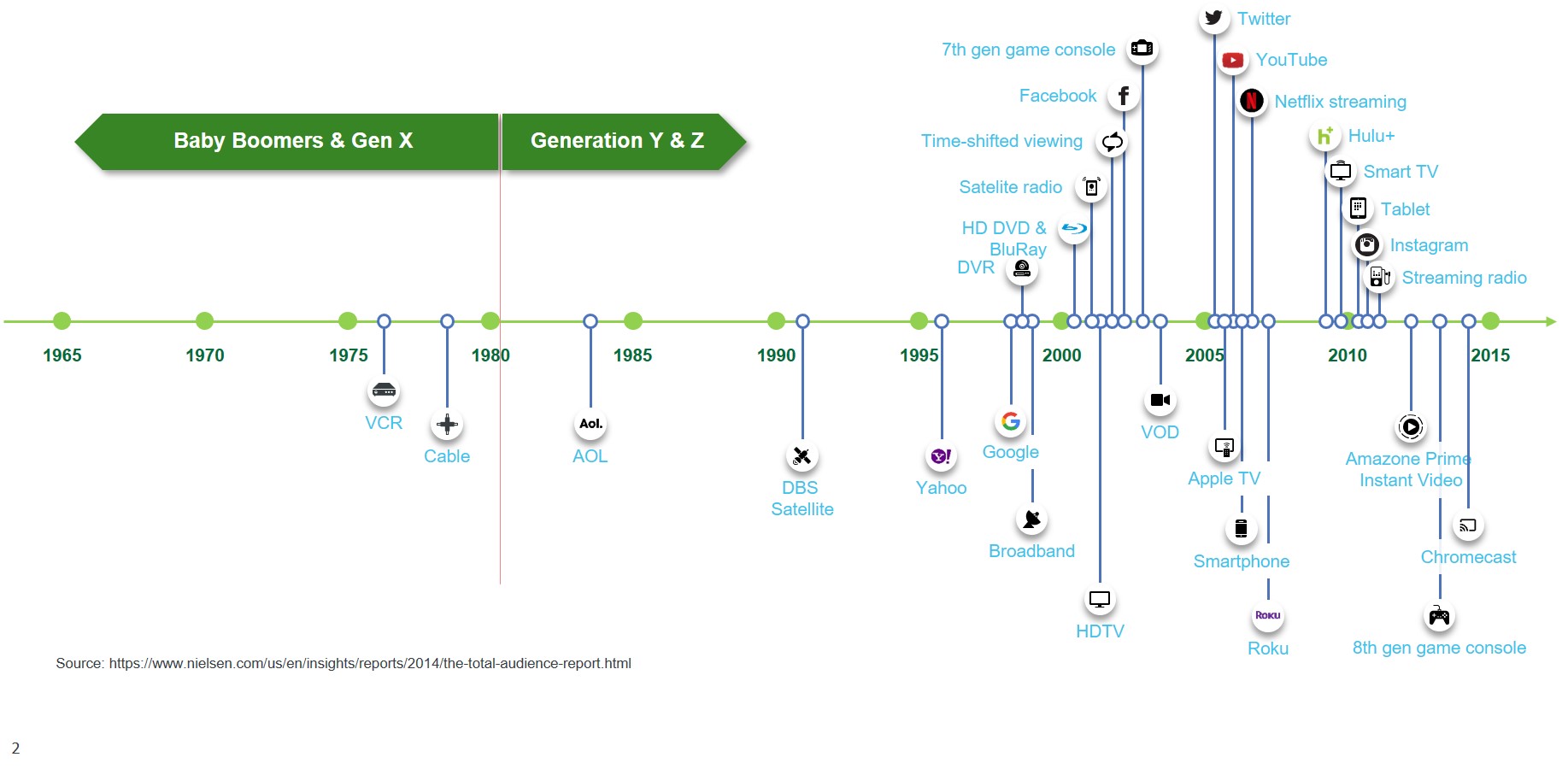How to lead across generations
By Jonas Bladt Hansen, 26. November 2018
Lots of books, blogs and articles have been written about leading generations. Reading descriptions about the different traits about generations is a great way to get a broad understanding of their needs and wants.
But as a leader, your focus should first and foremost be on leading people and not generations. It’s still about human-to-human interactions and not “Gen X to Gen Y” or similar. You must be careful not to expect specific behaviors just because one of your employees belong to a specific generation. It might come as a surprise, but there are not great differences of what the different generations WANT to achieve at work. However, there might be differences in HOW they want to achieve it.
In this blogpost I will look into
- What really defines generational traits/behaviors
- How technology has impacted generations
- Three things to focus on when leading different generations at work
How I got it wrong
Descriptions of generations can give you insights into behavioral traits and what might be expected of you. However, you can’t solely rely on them. You need to give them a reality check – as I learned the hard way:
A couple of years ago, when I was leading Arla’s internal communication department, I was asked to give a presentation about how we worked with this at the Copenhagen Business School. I was excited to speak at my former school and to present in front of Generation Y. I expected that they would embrace the flexible workplace and decided to tell them about all the great new digital channels we implemented at that time. I also told them about things happening in the near future and how that would enable us to offer great work experiences.
To my surprise, many of the questions I received after my presentation were focused around data privacy and a healthy work-life balance.
I must admit that I was a bit surprised. I thought this generation who grew up during the rise of Social Media would not really care about data privacy and prefer a flexible over work-life balance. On that day, I experienced how wrong one can get by making assumptions based on general definitions of generations.
This experience, and my experience in leading younger generations at work, has made me very cautious of expecting certain kinds of behaviors from generations.
“It’s not that people born after 1980 are narcissists, it’s that young people are narcissists, and they get over themselves as they get older.”
– Elspeth Reeve, The Atlantic
As Elspeth Reeves indicates, there are different effects that define people’s traits and sometimes these get mixed up. Baby Boomers were called the “Me” generation when they were young. The same label is being used to describe Millennials today!
What really defines generational traits/behaviors
Let’s take a look at three effects that often get mixed up when speaking about generations – age, cohort, and periodic. If you mix them up, you could make wrong assumptions about people. As a result, you could recruit the wrong people, design the wrong workplace experiences, promote the wrong person or set the wrong expectations towards your employees.
Age effects
These traits increase or decline during your period of life and they are not specifically linked to the time you grew up in. For instance, younger people are less likely to vote and engage in politics compared to older people. This is not a generational issue, but an age issue.
In 2003 a very comprehensive study concluded that traits such as contentiousness, agreeableness, neuroticism, openness and extraversion changed during a life-time. Contentiousness (discipline and ability to organize) and agreeableness (warmth, generous, helpful) increased over time. Openness declines over time which indicates that older people might prefer to spend time with people they know, while younger people a more open to establish new friendships.
Cohort effects
These are the effects that lead to generational thinking and acting.
A cohort effect can be a by-product of a historical event that has taken place and that has shaped the thinking of a whole generation. Growing up during World War 2, The Great Depression – or in freedom and prosperity during the 1990’s – has shaped people’s thinking in different ways.
The time you grow up in is also impacting your use of technology. People tend to stick with the defining technology of their time. For baby boomers, the phone was their defining communication technology. This means that they prefer phone conversations more than younger generations. The younger generations grew up with Social Media and chats and prefer them instead.
Even if there would be better communication channels available in the future, these generations would be more likely to stick with their “defining technology” and become the laggards when new platforms emerge – just as baby boomers are on Facebook at the moment.
Period effects
These effects are circumstances that affect everyone simultaneously. For instance, the 9/11 attack has changed people’s view on what our intelligence services should be allowed to do in order to prevent attacks – across generations.
To sum up, it is important to distinguish between:
- age effects that will change over time
- period effects that affect all generations
- cohort effects that shapes the thinking of predominantly one generation
How digital has impacted generations
Let us take a look at how the digital evolution has had an impact on generational traits. Societal events also play a major role.
![]() In 2015, The Nielsen Company released this overview of the evolution in channels/devices since the 1960’s. This is helpful to understand the defining technologies throughout generations. It is easy to see that generations Y and Z has had a lot more to choose from when they grew up than Baby Boomers and generation Xers – both in terms of channels and devices. There are lots of examples about how this affects the preferred channels across generations.
In 2015, The Nielsen Company released this overview of the evolution in channels/devices since the 1960’s. This is helpful to understand the defining technologies throughout generations. It is easy to see that generations Y and Z has had a lot more to choose from when they grew up than Baby Boomers and generation Xers – both in terms of channels and devices. There are lots of examples about how this affects the preferred channels across generations.
![]() For instance, during the presidential elections in the US, 43 % of people aged 65+ named television as the most helpful source of information. Only 12 % of the 18-29 year old thought of this. Instead, 35 % named social media (Pew Research Center, 2016).
For instance, during the presidential elections in the US, 43 % of people aged 65+ named television as the most helpful source of information. Only 12 % of the 18-29 year old thought of this. Instead, 35 % named social media (Pew Research Center, 2016).
This development has impacted generations in different ways. Here are my three take aways:
Personalization
Thanks to the internet and data gathering, communication, services and products has become more tailored today. Segmenting your target group based on generations is only one option among many. Things has become a lot more complex. As a leader you need to accept that you don’t have all the answers anymore. You need help – and the best help you can get is from a diverse workforce.
Convenience
is a keyword for Generation Y and Z as they are growing up in a period of massive choice. Baby Boomers and partly Gen Xers often had to accept clunky design because of limitations in choice. They have been used to follow instructions and accept bad user experiences. But you should be aware that your current ways of working in your organization could cause frustration among the younger generations if you limit their choices. Therefore, be explicit on what they can do and not do. Again, there are no guarantees that your older generations will not feel the same frustrations as the younger ones. They have also experienced consumer grade technology by now. But they can still remember the times when they had to use the typewriter and send a letter. And compared to that a lot of things seem easier today.
Impatience
There are indications that younger generations are becoming more impatient.
A Microsoft study revealed some significant differences in what we do when we get bored. 77% of people aged 18 to 24 responded “yes” when asked, “When nothing is occupying my attention, the first thing I do is reach for my phone,” compared with only 10% of those over the age of 65.
Research in the field of pop music has shown how music intros has become shorter since the 80’s. In the 80’s a music intro lasted around 20 seconds. In 2011 it was around 5 seconds.
Furthermore, social media has taken instant gratification to unprecedented levels, which could lead to short term thinking dominating over long-term thinking in order to get the next “fix”.
As a leader this could indicate, that you should be aware of different ways to stay in touch with your people. Baby boomers could prefer face to face conversations, while younger generations might be ok with you being available on digital channels so that they can reach you whenever needed.
Three things to focus on when leading different generations at work
Focus on people first
You should flex and adapt your leadership style to the individual – not the generation.
Generational traits can help you understand certain ways of thinking and behaviors. Use it as a guideline but make sure you focus on the person in front of you instead of the generational label the person has. Make sure you understand the wants and needs of your employees. Be clear and concise in your expectations and how you convey them. Consider to do some rounding each day to make sure you know how your employees are feeling and if they need any help to get their job done – and tell them how their work makes a difference. Everyone wants to know that their work matters!
Foster a learning – and unlearning culture across generations
Job experience is becoming less important as we live in a rapidly changing world where job roles will change faster than ever before. However, each generation has certain habits and learned different things. Regardless if you are Gen Z or a Baby Boomer, one of the most important capabilities will be your ability to learn and unlearn. As a leader, you need to foster a culture where this is possible. You need to understand the changes that are going on in society and be able to identify and mitigate the emerging skill gaps among your employees. A job swap between young and old could be a way to ensure a knowledge exchange between young and old. Watch this TED talk with Chip Conley to get some inspiration on how generations can learn from each other.
Be consistent
Today, we have endless communication and collaboration opportunities. As I have argued, people tend to stick to their defining technology when they grew up. The many opportunities cause confusion and frustration in organizations if nobody knows where to find information. Therefore, you need to be consistent. Consistency can sometimes be more important than choice. You need to make it clear what you communicate where and when – and stick to it. Tell your team in which situations they HAVE to use specific channels /platforms and in which situations they can do whatever they like.
It’s all about people
As a leader, you are not only leading in times of rapid change. You are also leading a diverse workforce with up to five different generations at work at the same time. And if that’s not enough, the job market has turned 180 degrees. Today, employees choose who they want to work for. Not the other way around! Use this to your advantage. Be a responsive leader. Accept that you are consciously incompetent. In a world that is increasingly complex you can be tempted to simplify things. Make sure you have a diverse workforce around you that is challenging you. But do also make sure, that diversity does not necessarily mean having one from each generation around you. It’s a matter of having the right people around you.
Looking for a thought-provoking speaker
with knowledge of the future
and how to turn it into daily life?
Do you need input on how to get started?
Take a look at at our categorized toolbox here
– it’s all free
Are you looking for
a coach or
a professional mentor?







